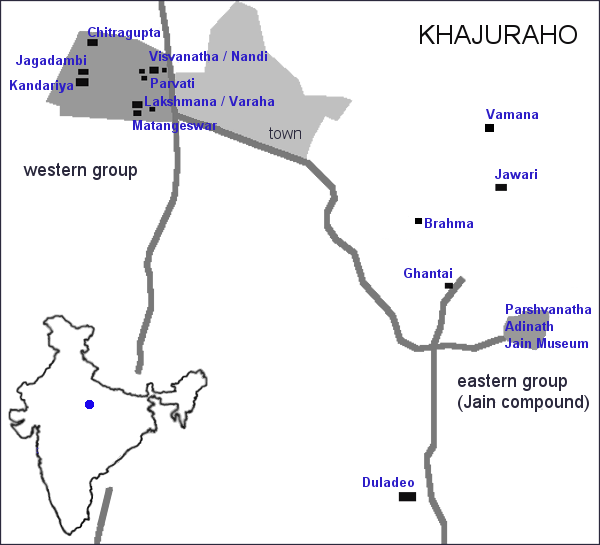The temples of Khajuraho
a photo documentation

Navigation-map of the Khajuraho temple locations
30.04.2010 / last updated: 12.12.2010 (bug fix Kmap)
Khajuraho
It was known as Vatsa in ancient time, Jejakabhukti in medieval times, and
Bundelkhand from 14th century on. Khajuraho played a significant role in indian history.
The Chandelas, who rose to power during the early 10th century AD., decorated their
Capital at Khajuraho with tanks and temples according to the local tradition.
There have been up to 85 temples originally, but now only around 25 remained and stand in
varying stages of preservation.
The place lost its importance around 1500 AD.
Most of these temples are built of sandstone, except the Chausath Yogini, Brahma and
Lalguan Mahadeva, which are constructed of granite. The temples belong to the Shiva, Vaishnava and
Jaina sects and they mark the culmination of the central indian building style revealing
distinctive peculiarities of plan and elevation. These compact temples without any enclosure walls
are erected on a high platform. Normally the temples consists of a Garbhgriha, Antarala, Mandapa
and Ardhamandapa.
The Khajuraho temples mark the highest development of indian architectural design. The
sculptures represented at Khajuraho include the cult-images, Parivara Devatas, Apsaras or Sura-Sundaris,
secular and animal sculptures and their maturity can be seen at Kandariya Mahadeva temple, which
displays tall and slender figures with distinctive physiognomy.
The erotic figures have given us the finest sculptural compositions, which vibrate with a
rare sensitiveness and warmth of emotion and are remarkable for their sculptural quality.
The most important temples at Khajuraho include
Lakshmana,
Vishvanatha,
Kandariya Mahadeva,
Jagadambi,
Chitragupta, Chaturbhuja,
Duladeo,
Ghantai etc.
[source: archaeological survey of india]
